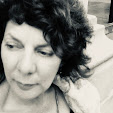THE GHOSTS OF ITALY & STILL LIFE WITH SAINTS
'An artist and photographer who has developed into a writer.'
Interview by Valentina di Cesare
Photos and narrative wanderings from a hilltop town in Campania, Italy
THE GHOSTS OF ITALY & STILL LIFE WITH SAINTS
'An artist and photographer who has developed into a writer.'
Interview by Valentina di Cesare



© 2006-2025 L'Americana. Unauthorized use and/or duplication of this material, including photographs, without express and written permission from this blog’s author and/or owner is strictly prohibited. Excerpts and links may not be used, without full and clear credit given to L'Americana with appropriate and specific direction to the original content. All rights reserved by Angela Paolantonio.